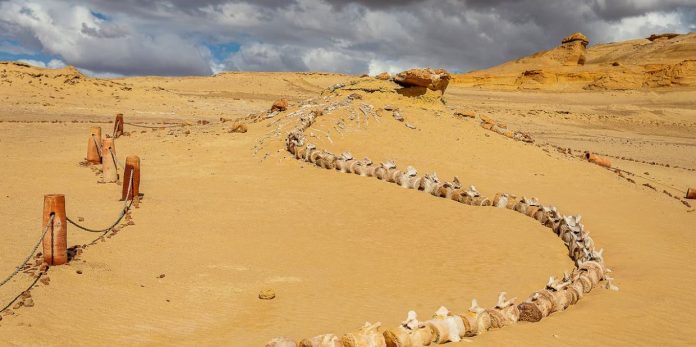Ancient Egyptian history is brought to life by a cast of thousands, from Tutankhamun’s gilded death mask to the pyramids’ enigmatic Sphinx. But drive 100 miles south west of Cairo into the vast sandscape of the Western Desert, and it’s possible to see the clock wind back even further — to a time when Egypt was populated not by kings but monsters.
Here, at the end of a long, unsealed road is Wadi al-Hitan, a 75sq-mile UNESCO World Heritage Site said to hold the key to one of the greatest mysteries of evolution.
You wouldn’t think so looking at it. There’s no life in this sand valley: no houses, no trees, no water — just mile after mile of desert stretching in every direction, as endless and golden as all the riches of the pharaohs put together. After the hubbub of Cairo, the silence is profound.
Though travellers flock to see the riches of Ancient Egypt in the Valley of the Kings, Wadi al-Hitan remains a largely hidden treasure. Yet this remote site tells a powerful story of life on Earth, buried by the literal sands of time and now brought to the surface by wind erosion and the meticulous work of palaeontologists.

Fossil fans mostly visit the valley on day trips from Cairo. What they find among the sands is rocks sculpted into alien shapes by the passage of millennia. Bulbous pavilions, squat rotundas and giant toadstools dot the landscape, pockmarked by the relentless wind. Between them runs a sandy path, distinguishable from the rest of the desert only by the tidy stones arranged along its edges and the overlapping footprints of visitors.
This is one of the most barren environments on Earth and yet, as walking tours scrunch softly uphill between the eerie rock formations, there are signs of prehistoric life: smooth mollusc shells might catch the light; there are coin-shaped fossils of ocean creatures called nummulites to discover; even sharks’ teeth can be found here.
They’re confusing things to find in a desert 100 miles from the coast, but 40 million years ago the shape of the continents was very different and the whole of what’s now North Africa was submerged beneath a shallow ocean called the Tethys.

There are bigger clues to this enigmatic past, too — bone fragments scattered like puzzle pieces, vertebrae the size of concrete blocks. But what’s most dramatic and surprising is the well-preserved skeleton of an enormous predator laid out on the sand at the end of the path, its spine the length of a cricket pitch, its ribs splayed on either side like stumps knocked down by a spin bowler.
“When scientists first discovered this creature, they thought it was a gigantic marine reptile,” says Hesham Sallam, lead palaeontologist at Wadi al-Hitan. “So they named it Basilosaurus, which means ‘king lizard’. It was only later that they realised it’s actually an ancient whale.”
Palaeontologists have been uncovering prehistoric whales here for over a century. Around 1,000 individuals have been identified, making this the biggest whale graveyard on Earth, and one of the most important palaeontological sites. That’s why, in a nod to Egypt’s more famous burial site — the Valley of the Kings — they named it Wadi al-Hitan, the Valley of the Whales.
There are about a dozen whale skeletons for visitors to tour among the sands, all identified as prehistoric Basilosaurus or Dorudon. They have been dated to around 37 to 40 million years old, which means they were alive during the late Eocene period. Laid out like an open-air exhibition, their remains are connected by paths for visitors to trace around each one.

The bones are fascinating to explore, but they’re also crucial to understanding one of the most bizarre stories of evolution — and the key to this can be found in Wadi al-Hitan’s small, subterranean museum.
Here, alongside a pair of metre-long Basilosaurus skulls baring terrifying teeth, are the monster’s most astonishing (and oddly comical) feature: a pair of tiny hind legs, complete with thigh bones, shin bones, ankles and matchstick feet.
“When you think about it, it’s bizarre that whales are air-breathing mammals, but they live in the ocean,” explains Sallam. “Scientists hypothesised that they must have originated on land, but later went into the water and evolved into the giants we know today, losing their legs in the process. But for decades they had no proof.”
These leg bones, discovered in 1989, are a crucial link in that transformation. They’re puny, no bigger than a human arm, and attached to this six-tonne whale they would have been useless for walking. But they’re clear evidence that whales did once live on land and gave up their terrestrial lifestyles to return to the ocean.
“It’s like being able to see evolution with your naked eye and touch it with your hand,” Sallam says. “You have to be careful where you walk, because there are fossils everywhere and you never know what new discovery may be under your feet.”
This article was produced by National Geographic Traveller (UK).

















